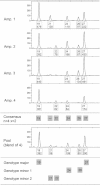Consensus and pool profiles to assist in the analysis and interpretation of complex low template DNA mixtures
- PMID: 22131037
- PMCID: PMC3538021
- DOI: 10.1007/s00414-011-0647-5
Consensus and pool profiles to assist in the analysis and interpretation of complex low template DNA mixtures
Abstract
Forensic analysis of low template (LT) DNA mixtures is particularly complicated when (1) LT components concur with high template components, (2) more than three contributors are present, or (3) contributors are related. In this study, we generated a set of such complex LT mixtures and examined two methods to assist in DNA profile analysis and interpretation: the "n/2" consensus method (Benschop et al. 2011) and the pool profile approach. N/2 consensus profiles include alleles that are reproducibly amplified in at least half of the replications. Pool profiles are generated by injecting a blend of independently amplified PCR products on a capillary electrophoresis instrument. Both approaches resulted in a similar increase in the percentage of detected alleles compared to individual profiles, and both rarely included drop-in alleles in case mixtures of pristine DNAs were used. Interestingly, the consensus and the pool profiles often showed differences for the actual alleles detected for the LT component(s). We estimated the number of contributors using different methods. Better approximations were obtained with data in the consensus and pool profiles compared to the data of the individual profiles. Consensus profiles contain allele calls only, while pool profiles consist of both allele calls and peak height information, which can be of use in (statistical) profile analysis. All advantages and limitations of the various types of profiles were assessed, and based on the results we infer that both consensus and pool profiles (or a combination thereof) are helpful in the interpretation of complex LT DNA mixtures.
Figures



Similar articles
-
Low template STR typing: effect of replicate number and consensus method on genotyping reliability and DNA database search results.Forensic Sci Int Genet. 2011 Aug;5(4):316-28. doi: 10.1016/j.fsigen.2010.06.006. Epub 2010 Jul 22. Forensic Sci Int Genet. 2011. PMID: 20655289
-
Assessment of mock cases involving complex low template DNA mixtures: A descriptive study.Forensic Sci Int Genet. 2012 Dec;6(6):697-707. doi: 10.1016/j.fsigen.2012.04.007. Epub 2012 May 19. Forensic Sci Int Genet. 2012. PMID: 22613779
-
Comparison of different interpretation strategies for low template DNA mixtures.Forensic Sci Int Genet. 2012 Dec;6(6):716-22. doi: 10.1016/j.fsigen.2012.06.006. Epub 2012 Jun 26. Forensic Sci Int Genet. 2012. PMID: 22739132
-
Human Leukocyte Antigen alleles as an aid to STR in complex forensic DNA samples.Sci Justice. 2020 Jan;60(1):1-8. doi: 10.1016/j.scijus.2019.09.003. Epub 2019 Nov 23. Sci Justice. 2020. PMID: 31924284 Review.
-
Separation/extraction, detection, and interpretation of DNA mixtures in forensic science (review).Int J Legal Med. 2018 Sep;132(5):1247-1261. doi: 10.1007/s00414-018-1862-0. Epub 2018 May 25. Int J Legal Med. 2018. PMID: 29802461 Review.
Cited by
-
A Review of Probabilistic Genotyping Systems: EuroForMix, DNAStatistX and STRmix™.Genes (Basel). 2021 Sep 30;12(10):1559. doi: 10.3390/genes12101559. Genes (Basel). 2021. PMID: 34680954 Free PMC article. Review.
-
A New Computational Deconvolution Algorithm for the Analysis of Forensic DNA Mixtures with SNP Markers.Genes (Basel). 2022 May 15;13(5):884. doi: 10.3390/genes13050884. Genes (Basel). 2022. PMID: 35627269 Free PMC article.
-
Modeling one complete versus triplicate analyses in low template DNA typing.Int J Legal Med. 2014 Mar;128(2):259-67. doi: 10.1007/s00414-013-0924-6. Epub 2013 Oct 5. Int J Legal Med. 2014. PMID: 24096959
-
Response to Grisedale and Van Daal: comparison of STR profiling from low template DNA extracts with and without the consensus profiling method.Investig Genet. 2013 Jan 3;4(1):1. doi: 10.1186/2041-2223-4-1. Investig Genet. 2013. PMID: 23286546 Free PMC article.
-
Improved analysis of long STR amplicons from degraded single source and mixed DNA.Int J Legal Med. 2013 Jul;127(4):741-7. doi: 10.1007/s00414-012-0816-1. Epub 2013 Jan 10. Int J Legal Med. 2013. PMID: 23306520
References
-
- Matai A, Harteveld J, Sijen T (2010) The Next Generation Multiplex (NGM™ Kit) in a forensic setting. Forensic News, July
-
- Tucker VC, Hopwood AJ, Sprecher CJ, McLaren RS, Rabbach DR, Ensenberger MG, Thompson JM, Storts DR. Developmental validation of the PowerPlex((R)) ESI 16 and PowerPlex((R)) ESI 17 Systems: STR multiplexes for the new European standard. Forensic Sci Int Genet. 2010;5:257–258. - PubMed
-
- Tucker VC, Hopwood AJ, Sprecher CJ, McLaren RS, Rabbach DR, Ensenberger MG, Thompson JM, Storts DR (2011) Developmental validation of the PowerPlex((R)) ESX 16 and PowerPlex((R)) ESX 17 Systems. Forensic Sci Int Genet. doi:10.1016/j.fsigen.2011.03.009 - PubMed
Publication types
MeSH terms
Substances
LinkOut - more resources
Full Text Sources

